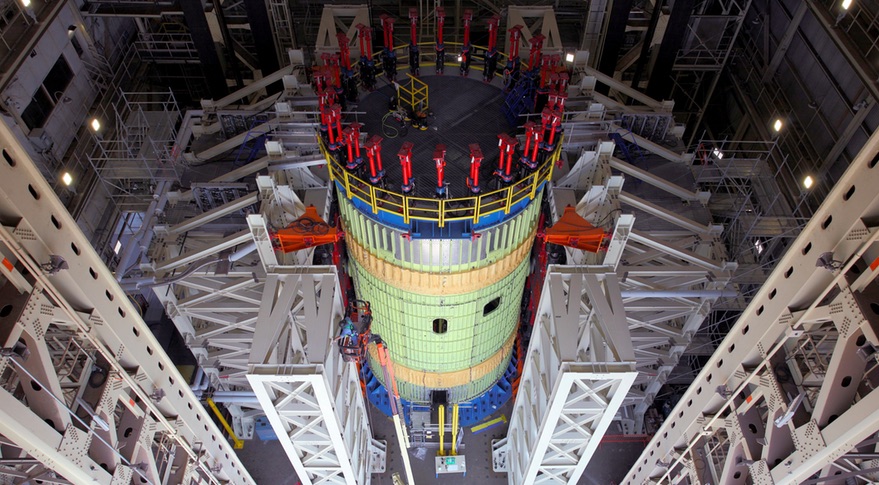National Space Council Seeks Urgency in NASA Exploration Plans

SILVER SPRING, Md. — The National Space Council will likely press NASA at its upcoming meeting to speed up its plans to return humans to the moon as the agency continues to study alternative approaches for the next flight of its Orion spacecraft.
Scott Pace, executive secretary of the National Space Council, said March 21 the need for urgency in NASA's return to the moon will be a theme of the council's next meeting March 26 in Huntsville, Alabama. That meeting, announced March 20, will include two panels of experts who will weigh in on the status of those plans.
"Our civil space sector, especially human spaceflight, I think needs a greater sense of urgency," Pace said in a luncheon speech at the American Astronautical Society’s Goddard Memorial Symposium here. "We're looking to the vice president to providing guidance on that charge at the next meeting." Vice President Mike Pence chairs the council.
Related: NASA Reassessing Date for first SLS launch
NASA Administrator Jim Bridenstine announced March 13 that the agency is looking at alternatives to the Space Launch System for flying Exploration Mission (EM) 1, the next uncrewed flight of the Orion spacecraft that will test the spacecraft on a mission around the moon. Bridenstine said that the reason for looking at the possibility of using commercial launch vehicles for that mission was to keep it on schedule for mid-2020.
Pace said that study is "absolutely not a slam" on Boeing, the prime contractor for the core stage of the SLS, whose difficulties have led to the risk of further delays in EM-1. "What it is meant to say is that we need to keep our schedule commitments, and that we're absolutely deadly serious about keeping those commitments to keep the American people engaged, to keep our stakeholders engaged, and keep our partners engaged."
NASA is also working with Boeing to look at ways to speed up development of SLS to keep it on schedule for a 2020 launch. Bridenstine hinted about those studies in a March 15 tweet, saying teams were "working overtime to accelerate the launch schedule" for SLS. Neither NASA nor Boeing have since elaborated on those efforts, despite requests to both organizations for additional details.
Breaking space news, the latest updates on rocket launches, skywatching events and more!
Pace alluded to that work in his speech, noting conversations he had with Jim Chilton, the senior vice president for space and launch at Boeing who introduced Pace at the luncheon. "I think he's got a great way forward and I look forward to working with him to have SLS be a success for EM-1 and EM-2," he said.
Among the topics that the ongoing study will look at, he said, is "alternatives to the 'green run'" for SLS, a static-fire test of the SLS core stage at the Stennis Space Center in Mississippi where the stage's four RS-25 engines are fired for the full duration of a launch, about eight minutes. Current plans call for the core stage to be shipped from the Michoud Assembly Facility in New Orleans, where it is being built, to Stennis for the green run test, and from there to the Kennedy Space Center for launch preparations.
Pace didn't elaborate on what those alternatives would be, but industry sources have said one possibility would be to skip the green run test entirely, which would cut several months from the current schedule. In its place, the core stage, attached to its solid rocket boosters and upper stage, would be fired briefly on the pad at KSC, similar to the static-fire tests that SpaceX performs for its rockets shortly before launch.
NASA's full fiscal year 2020 budget request document, released March 18, noted that NASA's human exploration and operations mission directorate "chartered an assessment of other activities planned to achieve a launch in 2020" of SLS on March 4. That study "will evaluate alternate approaches for hardware processing and facilities utilization for key components. The goal of this activity is to maintain an early as possible launch date." That review is scheduled to be completed by April 15.
That assessment will be followed by an "independent schedule risk review" to be led by the office of the chief financial officer at NASA. That review will be completed by late spring, after which NASA will consider "potential updates to the EM-1 and EM-2 launch planning dates."
The current agency baseline commitment date for EM-2, which will be the first crewed Orion mission, is April 2023, but Pace said it should be sooner. "In addition to getting EM-1 out, we also want to be in a position to fly EM-2 successfully and safely by 2022," he said.
Pace, in his remarks, emphasized the window of opportunity that exists now for NASA to implement its exploration plans, one that he suggested will be open for only a limited time. "NASA and industry have to execute on plan," he said. "We have a limited window here. We’re not racing the Soviet Union, but we're racing complacency."
- Read SpaceNews for the Latest Space Industry News
- Space Industry and Lawmakers Go to Defense of NASA's SLS Megarocket
- Latest News About NASA's Space Launch System (SLS)
This story was provided by SpaceNews, dedicated to covering all aspects of the space industry.

Jeff Foust is a Senior Staff Writer at SpaceNews, a space industry news magazine and website, where he writes about space policy, commercial spaceflight and other aerospace industry topics. Jeff has a Ph.D. in planetary sciences from the Massachusetts Institute of Technology and earned a bachelor's degree in geophysics and planetary science from the California Institute of Technology. You can see Jeff's latest projects by following him on Twitter.

